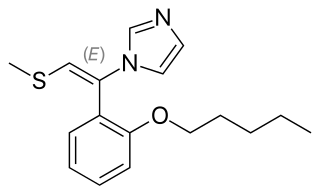In organic chemistry, polyenes are poly-unsaturated, organic compounds that contain at least three alternating double and single carbon–carbon bonds. These carbon–carbon double bonds interact in a process known as conjugation, resulting in some unusual optical properties. Related to polyenes are dienes, where there are only two alternating double and single bonds.

An antifungal medication, also known as an antimycotic medication, is a pharmaceutical fungicide or fungistatic used to treat and prevent mycosis such as athlete's foot, ringworm, candidiasis (thrush), serious systemic infections such as cryptococcal meningitis, and others. Such drugs are usually obtained by a doctor's prescription, but a few are available over the counter (OTC). The evolution of antifungal resistance is a growing threat to health globally.
ATC code J02Antimycotics for systemic use is a therapeutic subgroup of the Anatomical Therapeutic Chemical Classification System, a system of alphanumeric codes developed by the World Health Organization (WHO) for the classification of drugs and other medical products. Subgroup J02 is part of the anatomical group J Antiinfectives for systemic use.

Ciclopirox is a synthetic antifungal agent for topical dermatologic treatment of superficial mycoses. It is most useful against tinea versicolor. It is sold under many brand names worldwide.

Terconazole is an antifungal drug used to treat vaginal yeast infection. It comes as a lotion or a suppository and disrupts the biosynthesis of fats in a yeast cell. It has a relatively broad spectrum compared to azole compounds but not triazole compounds. Testing shows that it is a suitable compound for prophylaxis for those that suffer from chronic vulvovaginal candidiasis.
Polyene antimycotics, sometimes referred to as polyene antibiotics, are a class of antimicrobial polyene compounds that target fungi. These polyene antimycotics are typically obtained from some species of Streptomyces bacteria. Previously, polyenes were thought to bind to ergosterol in the fungal cell membrane and thus weakening it and causing leakage of K+ and Na+ ions, which could contribute to fungal cell death. However, more detailed studies of polyene molecular properties have challenged this model suggesting that polyenes instead bind and extract ergosterol directly from the cellular membrane thus disrupting the many cellular functions ergosterols perform. Amphotericin B, nystatin, and natamycin are examples of polyene antimycotics. They are a subgroup of macrolides.

Tioconazole is an antifungal medication of the imidazole class used to treat infections caused by a fungus or yeast. It is marketed under the brand names Trosyd and Gyno-Trosyd. Tioconazole ointments serve to treat women's vaginal yeast infections. They are available in one day doses, as opposed to the 7-day treatments commonly used in the past.

Econazole is an antifungal medication of the imidazole class.

Hamycin is a pair polyene antimycotic organic compounds described in India. It is a heptaene antifungal compound rather similar in chemical structure to amphotericin B except that it has an additional aromatic group bonded to the molecule. When pure, hamycin is a yellow, powdered solid. There are two versions of hamycin with very similar chemical structures: hamycin A and hamycin B.

Piroctone olamine is a compound sometimes used in the treatment of fungal infections. Piroctone olamine is the ethanolamine salt of the hydroxamic acid derivative piroctone.

Omoconazole is an azole antifungal drug.

Neticonazole (INN) is an imidazole antifungal for the treatment of fungal skin infections.

Microsporum audouinii is an anthropophilic fungus in the genus Microsporum. It is a type of dermatophyte that colonizes keratinized tissues causing infection. The fungus is characterized by its spindle-shaped macroconidia, clavate microconidia as well as its pitted or spiny external walls.

Tolciclate (INN) is an antifungal medication.
Sulbentine is an antifungal.

Lucimycin is a macrolide antibiotic synthesized by the bacterium Streptomyces lucensis. It belongs to the group of polyene antimycotics and was first isolated in the 1960s. It has seen only limited clinical use.
Janthinobacterium agaricidamnosum is a bacterium of the family Oxalobacteraceae and the genus Janthinobacterium that causes a soft rot disease of Agaricus bisporus. Because of this ability, it could help treating diseases caused by fungi in humans. Analyses have shown that jagaricin, a substance which is produced by J. agaricidamnosum, could have a major part for its antimycotic activity.

Aristolochia bracteolata also known as 'worm killer' in English due to its anthelminthic activity and trypanocidal effect, is a perennial herb growing from 10–60 cm tall. The plant is important in traditional medicine in Africa, India and the Middle East.
Antibiotic-Antimycotic is a solution that is commonly added to cell culture media to prevent contamination by various bacteria and fungi. It generally contains 10,000 units per milliliter penicillin, 10,000 micrograms per milliliter streptomycin, and 25 micrograms per milliliter amphotericin B.

D-Mycosamine is an amino sugar found in several polyene antimycotics. Structural analogs of these agents lacking this monosaccharide component do not exhibit substantial antifungal activity.













